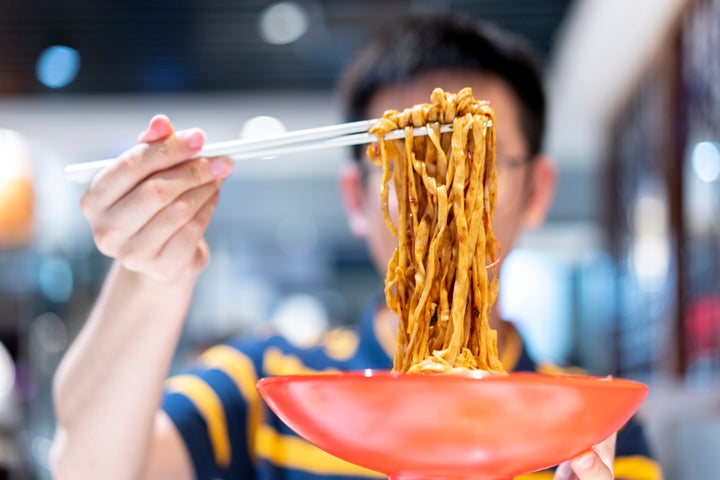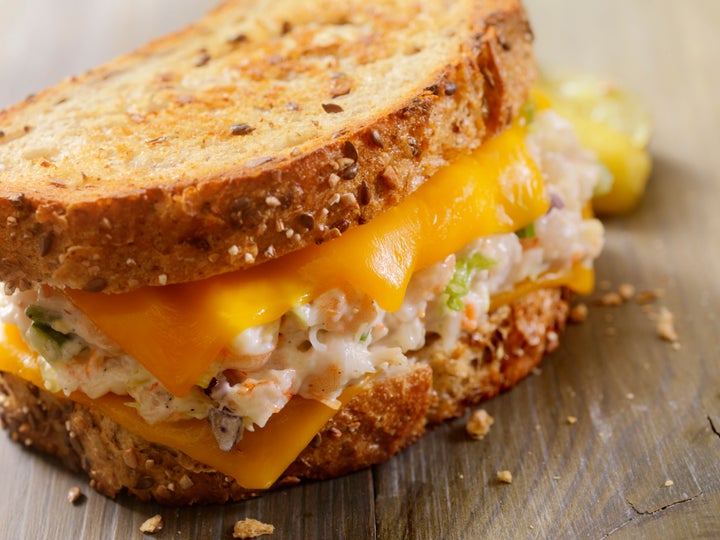
Chefs have long been combining ingredients that don’t typically go together (just think about all the fusion restaurants out there), but this idea is being taken to the next level with an emerging social media trend. The hashtag #ChaosCooking has over 1.6 million views on TikTok and thousands on Instagram. (Yes, IG is still a place for plenty of food inspiration.) It’s even namechecked in the Season 2 trailer of “The Bear.”
Aside from combining ingredients that wouldn’t normally go together, another cornerstone of chaos cooking is using whatever you happen to have on hand. In other words, you peek into your fridge and pantry, see what you need to get rid of and figure out a way to combine them. A TikTok video by user @MyCursedBrain is the perfect example of chaos cooking in action. In the clip, she combines edamame pasta, peanut butter, Everything But the Bagel seasoning, chilli powder, cucumbers and a handful of other ingredients for her take on a peanut butter noodle dish.
Other of her creative standouts include Big Mac pizza and Filipino spaghetti and lumpia burritos.
Stephen Chavez, a chef-instructor at the Institute of Culinary Education, is intimately familiar with the concept of chaos cooking. “When I was growing up, my mom would make ‘musgo salad’ in the summer and ‘musgo soup’ in the winter. Basically, this was anything in the fridge or pantry that ‘must go,’” he said, adding that he makes “musgo meals” all the time himself.
Chaos cooking can help cut down on food waste, but it’s helpful to have a few tips tucked into your apron if you actually want your meal to taste good. Here are seven tips to keep in mind while you chaos cook your heart out, according to four professional chefs.
1. Centre your dish around an ingredient you’re already good at cooking.
Part of the fun of chaos cooking is using ingredients you either have never cooked before or using them in a completely new way. But when you’re getting this creative, James Beard-winning chef Ken Oringer said it’s best to start with one core ingredient you’re already comfortable cooking.
For example, if you’ve already cooked rice, pasta, eggs or chicken countless times, start with that. Then, you can get funky with the other ingredients. “It’s those few surprise elements that bring the dish to the chaotic level,” Oringer said.
2. Figure out your theme.
After you’ve landed on a core ingredient, Chavez said it’s time to decide on a theme, or the flavour profile of the dish. “This will make the combining of ingredients much easier and it will give you a direction,” he said. “It’s like that situation when you are deciding where to go out to eat. Usually, people will start with international flavours, [asking], ‘Do you want Thai, Italian or Greek food?’ Using that same thinking, create your own ‘chaos cooking’ dishes with a theme or specific international flavour profile in mind.”
This doesn’t mean that just because you’ve decided on pasta for your core ingredient, for example, you have to stick with using Italian seasonings. In fact, going an unexpected way is what this trend is all about. But Chavez explains that deciding on a theme will help you figure out what seasonings or sauces to pair together. For example, if you decide you want your pasta noodles to have a Thai theme, you know that all your sauces and spices will be Thai-inspired.
3. Add a wild-card ingredient.
OK, you have your core ingredient and theme picked out. Now it’s time to get weird. Chef Dafne Mejia, who was a contestant on “Hell’s Kitchen,” said chaos cooking can be an opportunity to cook with something you’ve never cooked with before. As a recent guest on the “Bourbon Lens” podcast, she encouraged more people to cook with bourbon. “If you don’t have vinegar, you can use bourbon, which gives a dish a beautiful, smoky flavour,” she told HuffPost, adding that this makes for an especially yummy marinade for steak.
Another way Mejia said you can get creative is by using baking soda: “I’ve learned from Italian chefs that adding baking soda to tomato sauce-based dishes can balance out some of the acidity,” she said.
4. Cook your ingredients separately.
Chaos cooking can sound like just throwing a bunch of random ingredients into the same pot or pan, but Chavez said to resist doing this and to cook each ingredient separately. “If you are trying to cook [everything] at the same time in the same pan, you are destined to have sub-par results and poor textures,” he said. “Almost always the pan is overcrowded, the temperature drops, and you end up with a soft, steamed mess instead of a combination of exciting textures and flavours.”
For example, if you’re making stir-fry, the protein (whether it’s meat or tofu) will require more time in the pan than the veggies. Also, if the pan is too crowded and ingredients are piled up on top of each other, not everything will be cooked evenly. Instead, cook your protein in one pan and your veggies in another. If you’re making a meal with a bunch of veggies, keep in mind that some need to cook longer than others. For example, potatoes are thicker than carrots, so they should be boiled in different pots. Otherwise, you risk either the carrots getting too mushy or the potatoes too firm.

5. Make sure your ingredients balance each other out, flavour-wise.
Pro tip from Ann Ziata, a chef at the Institute of Culinary Education: Balance is key. “For a meal to work, it needs to be balanced by flavours, textures and somewhat nutritionally, too,” she said. She adds that every great dish has at least some element of all the basic tastes: sweet, salty, bitter, sour and rich. “They don’t all need to be in equal measure, but they all should be present for a meal to be truly delicious,” she said.
6. Add spices and flavours incrementally.
All four chefs say that another common mistake people make with chaos cooking is adding too many ingredients in an effort to make a dish more outrageous. “Each ingredient should be there with the intention to serve the dish,” Ziata said. If you’re debating adding another ingredient to your dish, she says to think about why you want to add it first. If it’s to balance flavour or texture, go for it. If it’s just for the heck of it or in an effort to make something “viral,” you might want to skip it.
Similarly, Oringer said it’s important not to add too much of a spice or sauce. “You can always add more, but it’s hard to balance out a dish if too much of something is already in there,” he pointed out. If you’re not sure how a combo will taste, try a small amount first before going all-in.
7. Consider the texture.
Last, Ziata and Mejia both say to consider the texture of your meal. “Texture will make or break a dish,” Ziata said. If your dish has a lot of baked or roasted elements to it, she recommends adding a sauce to prevent it from feeling too dry. If your dish is soft and mushy, she recommends adding something toasted or fried for a crunchy or crispy texture.
“No one wants to eat like they’re 2 or 95 years old,” Mejia said, echoing Ziata in saying that soft dishes need something crispy or crunchy. “You can really elevate a dish by balancing the texture.”
With these tips in mind, you’re ready to embrace the chaos. You just might find yourself obsessed with a completely new meal. Ramen bolognese, anyone?